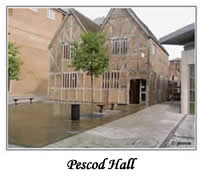When you say to people the name of my home town, Boston, the first thing they think of is the parish church, St Botolphs, otherwise known as ‘The Stump’. Built in the 12th century, this is the largest parish church in England, with the tower (or ‘stump’) being 272ft tall. It is believed to be called ‘The Stump’ as it was originally designed to be a lot higher. It is also believed that sacks of wool were used to help with the foundations when it was built.

During the 11th and 12th centuries Boston grew into a notable town and trading port with Europe, and became rich through the wool trade. The docks are still in use today. Boston is very proud of its history and this can be seen all over the town. In 1607, the pilgrim fathers first attempted to escape religious persecution and tried to flee to Holland, however they were arrested at Scotia Creek, Fishtoft, and put in the cells in the 14th century Guildhall in Boston. The cells and courtroom have been preserved and the Guildhall is now a museum. A memorial was erected at the place of the pilgrim fathers’ arrest in 1957.
In 1630, the vicar of St Botolph’s, John Cotton, was one of the founders of Boston, Massachusetts in America, after becoming disillusioned by the lack of religious freedoms in England at the time. He emigrated there in 1633.
Fydell House was home to the Fydell family, who were wealthy merchants in Boston. They dominated the town’s politics during the late Georgian period. The family owned the property from 1733-1936. When Mr Thomas Fydells’ wife passed away in 1813, their nephew Henry Rogers, who was the town clerk, occupied it. The Boston Preservation Trust acquired it in 1936. Today it is used as a college, and is also licensed as a wedding venue.
 |  |  |
The Masonic Lodge was designed around a plain brick building, with the Portico design based on the Temple of Dandour in Nubia, which borders Egypt and Sudan. It was designed by G Handford and built between 1860 and 1863.

The 15th century Pescod Hall was the property of a wealthy wool merchant. It was moved to its present position when Boston town centre was redeveloped, and is now used as a fast food outlet.
The Stump and Candle was previously known as ‘Martha’s Vineyard’ and ‘Rum Puncheon’. There is a blue plaque on the wall outside which notes that it was the birthplace of John Foxe (1517-1578) the author of ‘The Book of Martyrs’. I believe it is called the Stump and Candle as you can see the lantern of Boston Stump above the rooftop.
Hussey Tower is a local part of history which is connected to King Henry VIII. The gentleman who lived in Hussey Tower was called John Hussey. It is currently being renovated by Lincolnshire Heritage.
Lincolnshire Heritage has also been responsible for renovating Boston’s old workhouse, which is now known as Scott House, which has generated a lot of interest from genealogists and history enthusiasts.
Boston is now well known for its market, which has been running since the Middle Ages. Nowadays they are held on a Wednesday and Saturday, and people travel for miles to come and visit them. Boston also hosts a continental market which is nice if you enjoy trying different food and drink.
jennie
© jennie 2008
